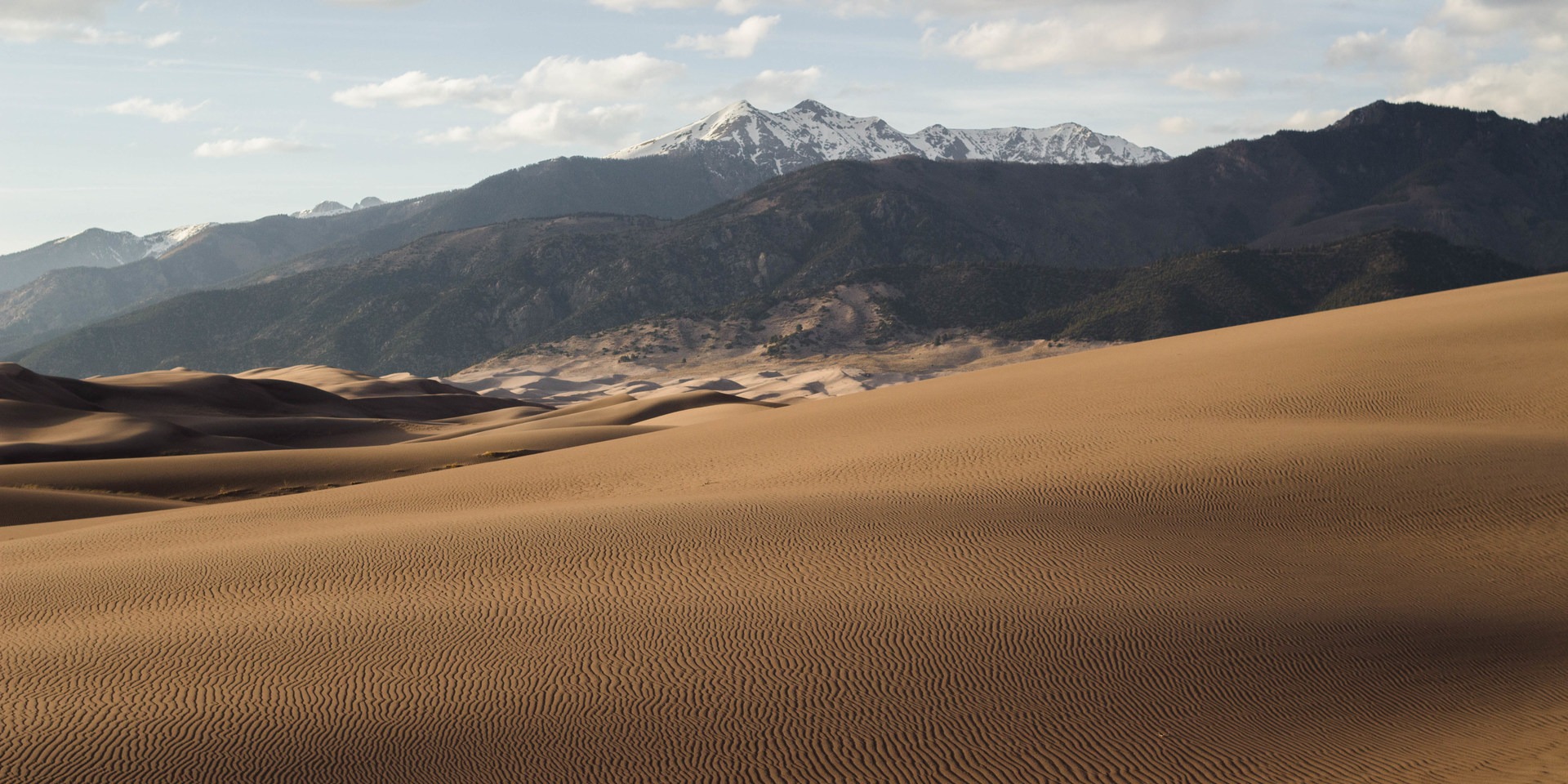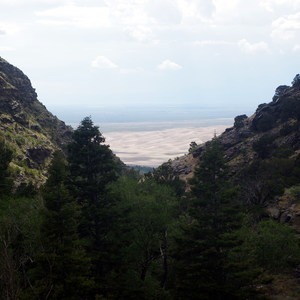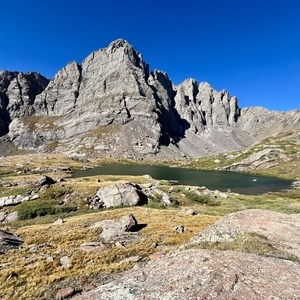You are here
The Great Sand Dunes National Park and Preserve is located in the San Luis Valley in southern Colorado, and it is tucked perfectly into the west base of the Sangre De Cristo Mountains Range. The main draw of the park is that it is home to the tallest sand dunes in North America, but what makes the park truly unique is its wildly diverse ecosystem ranging from sand dunes to its neighboring snowcapped mountain summits over 14,000 feet in elevation.
When hiking in Great Sand Dunes, the most popular route is to summit High Dune, which is the tallest dune you can see from the parking lots. While it certainly appears to be the highest dune in the park, it is neither the tallest nor the highest in elevation. From the visitor center, the hike to the High Dune summit covers about 700 vertical feet over roughly 1.25 miles and should take you around two hours to complete. Keep in mind that none of these numbers is exact since there is no set trail to follow. You can simply head to the dunes and pick the easiest, most difficult, or most interesting route you can find.
Although there are no lodging options within the park, there is a developed campground as well as backcountry campsites. Piñon Flats Campground is owned and operated by the National Park Service and offers 88 campsites, half of which are first-come, first-served, while the other half can be reserved in advance online. Dispersed car camping within the park is limited to 21 numbered roadside backcountry campsites located up Medano Creek Road (four-wheel drive required), 5 miles beyond Piñon Flats Campground.
For those looking to backpack, you can obtain a free overnight permit from the Great Sand Dunes Visitor Center, which is open every day year round except winter holidays. It is open from 9:00 a.m. to 4:30 p.m. Labor Day through Memorial Day Weekend and 8:30 a.m. to 6:00 p.m. Memorial Day Weekend to Labor Day. You can camp basically anywhere in the dune field as long as you stay north of High Dune and away from any growing vegetation. The rangers will advise you on where to camp, where to park, how to store your food, how to dispose of toiletries, and best practices for backpacking and camping in the dune field.
Do your best to avoid hiking in the middle of the afternoon when temperatures are at their peak. You are bound to hit a few steep sections that truly feel like you are hiking up an escalator going down, and using your hands uphill is not fun when the sand temperatures are upwards of 140 degrees. High afternoon temperatures make even sitting down to relax undesirable! The afternoon is also not ideal for photographers, as the light is flat and you miss out on the shadows that make the dunes so magical at sunrise and sunset.
After parking in one of the designated overnight lots, you'll make your way toward the dunes on a short sand path. You'll soon reach the surge flow of Medano Creek, which must be crossed to access the dune field. Snowmelt from the Sangre de Cristo Mountains feeds into the creek, and you will likely need to remove your footwear to avoid soaking through during the spring and summer months. At peak runoff in the spring, it's not uncommon to see children floating in tubes down the shallow creek that typically stays under one foot deep at peak flow.
After walking barefoot through the creek, continue barefoot until the sand naturally dries your feet. When adequately dry, take your first break to catch your breath and get your shoes/boots back on. Once you reach the summit of High Dune, you'll be treated to wide open views of the dune field with Star Dune to the west (the highest dune you can see) as well as the Sangre de Cristo Mountains to the east. From the eastern part of Colorado, people are accustomed to vast flat plains to the east and the Rocky Mountains to the west; they are conditioned to think, "Mountains mean west, flat plains mean east." This trend is reversed at Great Sand Dunes, where the San Luis Valley lies to the west and the Sangre de Cristo Mountains rise the east, and it's easy to get turned around.
From the summit of High Dune, try to pick out a route that looks desirable and just start hiking! As long as you stay north of High Dune you can find your favorite viewpoint and set up your tent for the night. The majority of all visitors into the dunes do not hike beyond High Dune, so the further you get from High Dune, the more likely you are to ensure complete and utter solitude.
The late afternoons and evenings are notoriously windy, so try and find a suitable spot for your tent, set it up and get that rain fly on as quickly as possible to keep the sand out. You'll want to make sure you bring extra long stakes for your tent. They do work! After about the first six inches of sand, you'll notice it's more packed down. You should also consider bringing some plastic grocery bags to use as sand bags in case you need them. Now that your campsite is set up, lay down in the form-fitting sand and take a nap or soak in every minute of the sunset.
Sunrise and sunset are the absolute best times in the dunes. The colors and the shadows are unrivaled. The views change by the minute, so if you plan on doing some photography out there, make sure that you've scouted out your location, and have the lens you need on the camera; if you do have to change lenses, do it in your tent to avoid sand particles. Adjust to your desired setting, and be ready to shoot!
For astrophotographers, Great Sand Dunes National Park boasts some the darkest night skies in the entire country. Prepare yourself to be absolutely blown away by the luminance of the stars on a clear night. I would suggest picking a night with a half-moon that doesn't rise until late night or early morning. You can then shoot sunset, nap for a couple hours, shoot the darkest night skies you've ever seen, sleep a few more hours, and shoot the dunes illuminated by moon before twilight.
Camping in the dunes is an amazing and unique experience. If it's even remotely windy, you're going to get filthy, you're going to be frustrated, and sand will get everywhere. Even without wind, sand manages to get absolutely everywhere. If you have any camping gear that you care about, leave it at home! Sand will get in every button, zipper, switch, knob, toggle, and every crevice you can imagine. The Great Sand Dunes National Park and Preserve is one of the most remote and most unique places you will ever camp.
The sand dunes are fully exposed. Bring adequate water, clothing, and sunscreen.








Comments
Once to the dunes there were hundreds of people that had set up camp along the creek and the smaller dunes closest to the parking lot. I picked a route that I thought would get me a good view and just started hiking upward. You can go whatever way you please, cut across dunes, etc and once you get up to the first ridge line the views towards the mountains are spectacular. I definitely took the long way to the high dune but it made the trip more interesting.
I would love to go back just not on Sunday afternoon of Memorial Day Weekend
Sign In and share them.